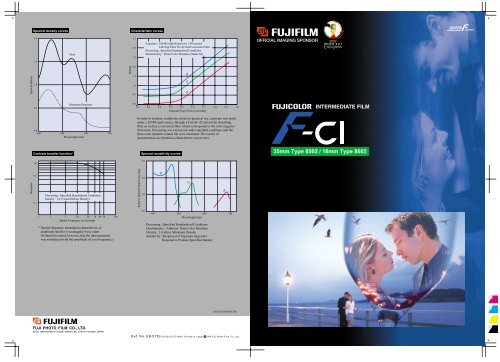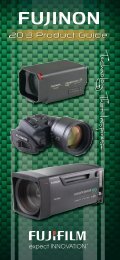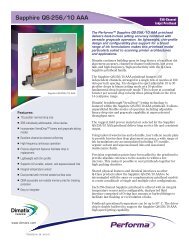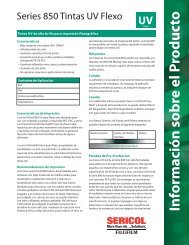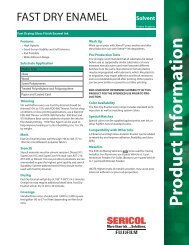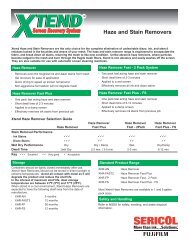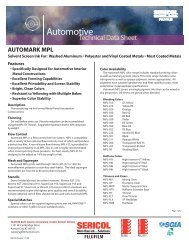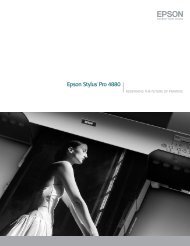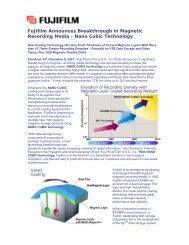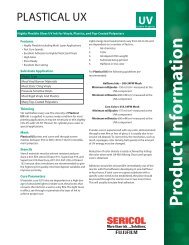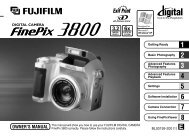F-CI Brochure - Fujifilm USA
F-CI Brochure - Fujifilm USA
F-CI Brochure - Fujifilm USA
You also want an ePaper? Increase the reach of your titles
YUMPU automatically turns print PDFs into web optimized ePapers that Google loves.
S<br />
uperbly natural color and tonal reproduction<br />
for outstanding cinematic impact.<br />
General Properties<br />
Fujicolor Intermediate Film F<strong>CI</strong> is a high-definition, ultra-fine<br />
grain intermediate stock designed for making color master<br />
positives by printing from original negatives or making<br />
duplicate negatives by printing master positives on F<strong>CI</strong> material.<br />
This intermediate stock is designed with special emphasis on<br />
exact reproduction of the gradation and color balance of<br />
originals. In addition, the speed balance of all the emulsion<br />
layers is designed to provide optimum results when making<br />
prints from color-mask incorporated color negatives or other<br />
color duplicating films.<br />
Film Structure<br />
Three emulsion layers which are respectively sensitive to red,<br />
green, and blue light are coated on a safety base together with<br />
yellow filter, protective, and other layers, and each emulsion<br />
layer is again a stack of three emulsion layers designed to<br />
achieve extremely fine grain and a full range of tones. The<br />
emulsion layers which contain various ingredients required to<br />
record an image, such as light-capturing silver halides and dyeforming<br />
couplers, form dye images and an orange-colored<br />
mask image when exposed to light and processed. This color<br />
mask image plays an important role in making color release<br />
prints of excellent color reproduction. There is an anti-halation<br />
layer provided between the base and the emulsion layers, and a<br />
black backing layer is provided on the other side of the film<br />
base to provide anti-halation, anti-static, and anti-scratch<br />
properties and surface lubrication. This backing is removed<br />
during processing. The film structure is schematically<br />
represented below.<br />
Blue Sensitive<br />
Emulsion Layer<br />
(containing colorless<br />
yellow coupler)<br />
Green Sensitive<br />
Emulsion Layer<br />
(containing yellowcolored<br />
magenta<br />
coupler)<br />
Red Sensitive<br />
Emulsion Layer<br />
(containing redcolored<br />
cyan coupler)<br />
Before<br />
Processing<br />
Protective<br />
Layer<br />
Yellow Filter<br />
Layer<br />
Inter Layer<br />
Safety Base<br />
(Cyan Tint)<br />
Black Backing<br />
Layer<br />
After Exposure<br />
and Processing<br />
Yellow Dye Image<br />
Magenta Dye<br />
Image and Yellow<br />
Mask Image<br />
Cyan Dye Image<br />
and Red Mask<br />
Image<br />
Film Base Safelight<br />
Clear safety base (TAC) or polyester base (PET) is used.<br />
This film should be handled in total darkness or under safelight<br />
conditions. In the latter case a Fuji Safelight Filter No.4 or a<br />
Kodak Safelight Filter No.3 (both are dark green) should be<br />
used in combination with a 10-watt light, keeping the film at a<br />
distance of 1m or more from it. This film can also be handled<br />
under the same safelight conditions that are essential to color<br />
positive film in which case a Fuji Safelight Filter No. 101A or<br />
Kodak Safelight Filter No.8 (both are dark orange) should be<br />
used. If the film is to be exposed to these safelight conditions<br />
for extended periods, sufficient safety factor testing should be<br />
carried out before using the film.<br />
Printing<br />
In master position production, contact printers are usually<br />
employed. In the interest of image stability, however, it is<br />
desirable that a step contact printer be used. For duplicate<br />
negative production an optical printer can be used. In this case<br />
it is desirable to use an optical printer in conjunction with a wet<br />
gate projector to inhibit graininess deterioration due to the<br />
matting agent on the emulsion surface. Insert an ultraviolet<br />
absorbing filter (Fuji Filter SC-42 or Kodak Wratten Filter<br />
No.2E) and a heat-absorbing filter (Fuji Filter No.2043) in the<br />
light beam of the printer.<br />
Aim Density in Printing<br />
This film is designed to allow the same printing aim density for<br />
both master positives and duplicate negatives. Adjust the<br />
density settings on the printer so that the following density<br />
values (status M densitometry) may be obtained when a color<br />
negative of an 18% reflectance gray patch is appropriately<br />
exposed and processed under standard conditions.<br />
Reciprocity Characteristics<br />
This film is designed so that there is no need to adjust exposure<br />
or color balance with 1/200 to 1 second exposure times.<br />
Packaging Units and Perforations<br />
Film<br />
Width<br />
65mm<br />
35mm<br />
16mm<br />
(Cellulose<br />
triacetate<br />
base)<br />
Red Density<br />
Green Density<br />
Blue Density<br />
Film Length and Winding Type<br />
* 305m (Cellulose triacetate base)<br />
* 305m (Polyester base)<br />
305m (Cellulose triacetate base)<br />
305m (Polyester base)<br />
610m (Cellulose triacetate base)<br />
610m (Polyester base)<br />
*305m ✕ 2 (Single-perforated, type A winding)<br />
*305m ✕ 2 (Single-perforated, type B winding)<br />
*305m ✕ 2 (Double-perforated)<br />
*610m ✕ 2 (Single-perforated, type A winding)<br />
*610m ✕ 2 (Single-perforated, type B winding)<br />
*610m ✕ 2 (Double-perforated)<br />
Dmin +1.0 ±0.1<br />
Dmin +1.0 ±0.1<br />
Dmin +1.0 ±0.1<br />
Core / Spool<br />
65 ✕ 75 mm core<br />
65 ✕ 75 mm core<br />
35 ✕ 50 mm core<br />
35 ✕ 50 mm core<br />
35 ✕ 75 mm core<br />
35 ✕ 75 mm core<br />
16 ✕ 50 mm core<br />
16 ✕ 50 mm core<br />
16 ✕ 50 mm core<br />
16 ✕ 75 mm core<br />
16 ✕ 75 mm core<br />
16 ✕ 75 mm core<br />
Items marked with * are supplied on a special order basis.<br />
Shape, Pitch and Specification<br />
of Perforations<br />
P-4.740 mm (Positive perforations<br />
with short pitch)<br />
[lSO 3023 : 1988]<br />
N-4.740 mm (Negative perforations<br />
with short pitch)<br />
[ISO 491 : 1988]<br />
1R-7.605 mm (Single perforations<br />
with short pitch)<br />
2R-7.605 mm (Double perforations<br />
with short pitch)<br />
[lSO 69 : 1972]<br />
Processing<br />
This film is to be processed with Process ECN-2 and formulas<br />
published by Eastman Kodak for Eastman Color Negative Film.<br />
In the bleaching step, persulfate bleach, ferricyanide bleach or<br />
PDTA-ferric bleach (UL bleach) is used.<br />
Edge Markings<br />
The MR. CODE system [key number, film identification code (FI<br />
02), machine-readable bar code, film name (FUJI FCl), emulsion<br />
number, roll number, frame marks (5 perforations apart for<br />
65mm stock, 4 perforations apart for 35mm stock, no frame<br />
mark for 16mm stock) etc.] is printed as latent images.<br />
Raw Stock Storage<br />
Like other color films, Fujicolor Intermediate Film F<strong>CI</strong> Types<br />
may undergo certain changes in photographic properties during<br />
storage. Since these changes can be accelerated by heat and<br />
moisture in particular, it is recommended that raw stock be stored<br />
unpacked at temperatures below 10˚C (50˚F).<br />
Any package that has been taken out of cold storage should<br />
remain sealed until it reaches equilibrium with ambient<br />
temperature. If packages are opened too soon, moisture<br />
condensation on the film surfaces may occur.<br />
Exposed Film Handling<br />
Exposed films should preferably be processed as soon as<br />
possible. If exposed films cannot be processed within three days<br />
of exposure, they should be stored at temperatures below 10˚C<br />
(50˚F) and processed as soon as circumstances permit.<br />
Processed Film Storage<br />
Fujicolor Intermediate Film F<strong>CI</strong> Types are designed to resist<br />
color fading, but high temperatures and humidities accelerate<br />
changes in dye image quality. These conditions may also<br />
accelerate film base deterioration. To avoid such changes,<br />
processed films should be kept at a temperature of 15˚C (59˚F)<br />
with 30% to 40% RH for long-term storage (about 100 years),<br />
and at temperature of 20˚C (68˚F) with 40% to 50% RH for<br />
medium-term storage (about 50 years). In addition, it is<br />
recommended that processed films in storage be checked by<br />
visual inspection for changes (e.g., deformation, color fading,<br />
adhesion, mold) and by smelling for odor of acetic acid at<br />
intervals of a few years.


